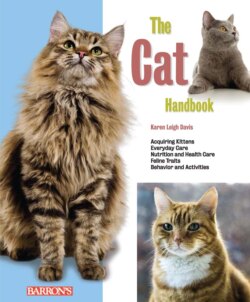Читать книгу The Cat Handbook - Karen Leigh Davis - Страница 38
На сайте Литреса книга снята с продажи.
Choosing a Healthy Cat or Kitten
ОглавлениеWhether you buy from a pet store, adopt from a shelter, answer a classified newspaper advertisement, purchase a purebred, or select a kitten from a neighbor’s litter, the animal you choose should have good muscle tone and bright, clear eyes, and he should be alert and friendly with a curious or playful attitude. A healthy cat or kitten should not be sneezing or showing mucus discharge around the eyes or nose. The ears should be clean and free of dark, crusty wax. Head shaking or ear scratching may indicate ear mites or other infections. The anus should be clean and free of any signs of diarrhea.
The environment where the cat or kitten has been kept should be clean and free of pungent animal odors. The animal’s coat also should be clean and free of fleas. To inspect the coat for fleas, rub your hand against the fur and look for fine grains of black dirt, which is really dried flea excrement, called “flea dirt” (see page 122). Flea signs are more prevalent behind the ears, on the back and at the tail base, where the cat cannot easily reach to lick clean.
To test the cat’s personality, tempt him with a feather or ribbon and see how playful and relaxed he is around strangers. If he appears fearful, hisses at you, cringes from your hand, or, in general, seems unused to being handled, you may want to look elsewhere for a better socialized animal. Of course, a shy, withdrawn cat that huddles quietly at the back of the cage at the animal shelter may come out of his shell and adapt successfully to life with a single adult or a quiet couple, if you have a house full of children, however, you will want to look for an outgoing, unflappable cat, one that sits at the front of the cage and reaches out his paw for attention.
